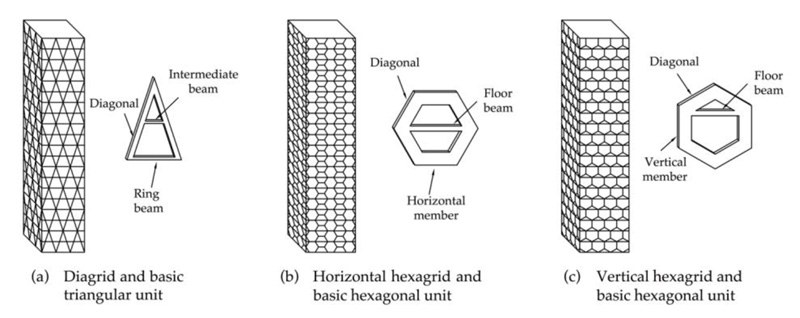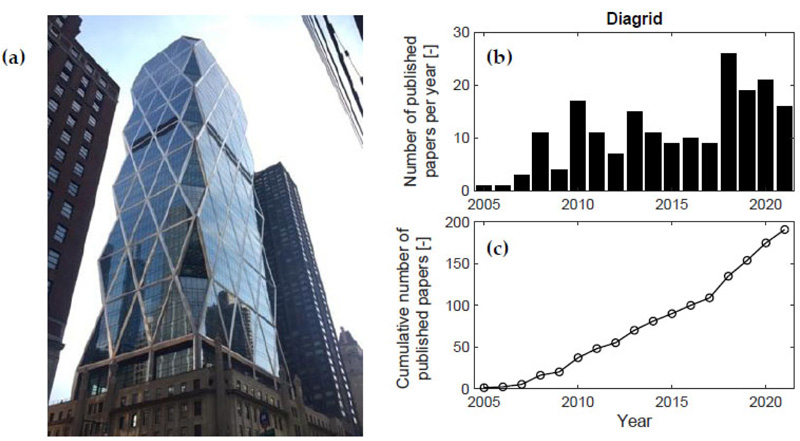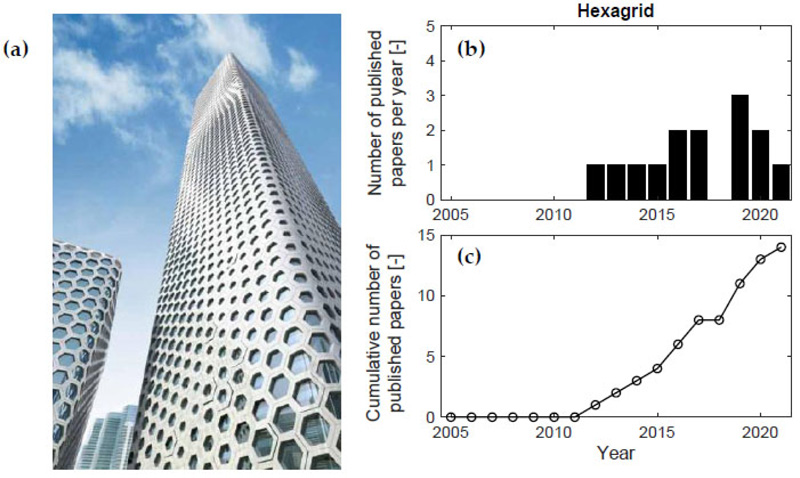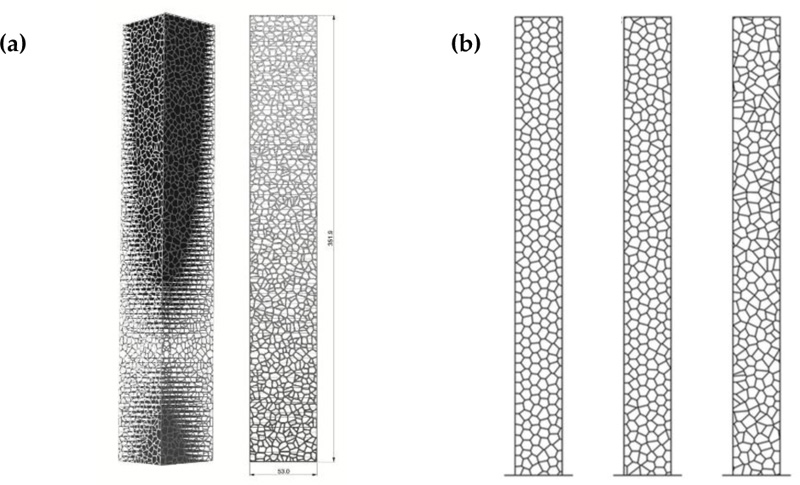All published articles of this journal are available on ScienceDirect.
Diagrid and Hexagrid Structures: New Perspectives in Design of Tall Buildings
1. INTRODUCTION
In the first decades of the 21st century, new structural systems have started to appear for the design and construction of tall buildings: the diagrids and the hexagrids. These systems are characterized by a grid pattern of diagonals placed over the external surface of the building (Fig. 1), which allows providing good structural performances while achieving noteworthy aesthetic and architectural effects. The diagrid is realized through a mesh of triangles made up of mega-diagonals and ring beams (Fig. 1a). The structural behavior of this system is mostly governed by the axial deformation of the diagonals, allowing to reach high levels of stiffness against lateral loads [1-4]. The hexagrid is a system composed of hexagonal beehive cells and can be of two main types: the horizontal hexagrid, which includes four diagonal members and two horizontal beams (Fig. 1b), and the vertical hexagrid, which includes four diagonal members and two vertical columns (Fig. 1c). In the case of hexagrids, the structural behavior is mostly dominated by the bending and shear deformability of the diagonals and horizontal or vertical members [5, 6]. This usually leads to a lower lateral stiffness performance for the hexagrid when compared to the diagrid.
Nowadays, both systems are finding continuous application in the design and construction of tall buildings worldwide, revealing an increasing interest in these structural systems by designers. Moreover, an increasing number of research groups within the academic environment are currently focusing their work on these grid solutions.
2. THE DIAGRIDS
The power of diagrids is that they do not need the conventional vertical columns, which are used in conventional frame systems to withstand horizontal and vertical actions. This is possible because the mega-diagonals can be used to resist both lateral and gravitational loads. This has offered several advantages, paving the way for the use of diagrids as efficient systems for tall building design and construction. Examples of diagrid strengths include their enhanced lateral stiffness compared to frame buildings [7], the capability to obtain remarkable architectural and aesthetic effects (Fig. 2a), the possibility to develop simplified methodologies to perform the structural analysis in the preliminary design stages [8-10], the capability to optimize their structural response and amount of structural weight simply by changing the geometrical pattern of diagonals [11-14], the possibility to speed up the construction processes due to the prefabrication of the main components [1], etc.
The diagrids have been recognized as a powerful solution for tall buildings since the beginning of the present century. This has led more and more research groups worldwide to investigate their behavior and suitability, which resulted in a steady increase of published papers in the last fifteen years. Fig. (2b and 2c) shows the yearly and a cumulative number of published papers, respectively, related to diagrids according to the SCOPUS database in the period 2005–2021 (data collected as of May 14, 2021). The first SCOPUS-indexed papers appeared in 2005, and few papers per year were published at the beginning. In the period 2010–2018, an average of about ten papers per year started to appear, whereas, in the last four years (2018–2021), almost twenty papers have been published each year (Fig. 2b). Today we can find a total of almost 200 papers on the subject, and the steadily increasing trend suggests increasing attention to this innovative structural solution for the design and construction of tall buildings (Fig. 2c).


3. THE HEXAGRIDS
Hexagrids share similar fundamental features with diagrids, as they are both structural systems relying on an external grid pattern. However, differently than diagrids, the structural behavior of hexagrids is based on the shear and bending rigidity of the hexagonal cells (Fig. 3a), which are made up of diagonals and horizontal or vertical elements [5, 6]. In the case of hexagrids, the definition of the unit cell and representative volume element requires particular attention, as it allows to simplify the hexagrid system and analyze it as an equivalent solid [15-17]. Calculations have shown that similar to the diagrid systems, the inclination of the hexagrid diagonals plays a key role in governing the shear and bending stiffness of the structure [15]. However, the hexagrid performance is usually found to be lower, in terms of lateral stiffness, than the one obtained with the diagrid [5, 6, 15]. This is probably the reason why, nowadays, we can find more examples of diagrids being designed and realized worldwide than hexagrids.

Fig. (3b and 3c) report the published papers related to hexagrids according to the SCOPUS database in the period 2005–2021 (data collected as of May 14, 2021). As can be seen, the total number of papers is sensibly lower than those related to diagrids (Fig. 1b and Fig. 1c) for comparison). Moreover, these papers started to appear later. The first indexed articles about hexagrids appeared in the period 2010–2015, while in that period, there were already several dozens of papers about diagrids (Fig. 2c). It is also noteworthy that publications about hexagrids are limited to a few papers per year, with a maximum of three papers published in 2018 (Fig. 3b). This suggests that hexagrids have been the focus of some research groups in the last decade, but they have not received as much attention as diagrids. The reasons for this might be related to the higher complexity of the structure, both from a design and construction point of view, as well as to the higher performance of the diagrid in terms of structural efficiency.
CONCLUSION
In this short perspective article, we have briefly surveyed the fundamental features of the most modern grid structural systems for tall buildings, i.e., diagrids and hexagrids. For both, the essential properties related to their structural behavior have been briefly described, together with an analysis of the popularity of diagrids and hexagrids among researchers and designers worldwide. In particular, by surveying the SCOPUS database, we have noticed that diagrids have received great and increasing attention from scholars in the last fifteen years, with the trend suggesting that more attention will be paid to these systems in the next years. Conversely, hexagrids have received less attention than diagrids, probably due to their higher complexity from a design and construction perspective, as well as due to their lower performance in terms of structural efficiency. Recent trends in the scientific literature also point towards new forms of grid structures for tall buildings, such as those using Voronoi tessellation for the generation of the external diagonal pattern (Fig. 4) [16, 17]. We expect future constructions to exploit diagrid, hexagrid, and grid solutions more and more in order to realize innovative, sustainable, and complex-shaped tall buildings.

CONSENT FOR PUBLICATION
Not applicable.
FUNDING
The sponsorship was guaranteed by the Basic Research Funds provided by Politecnico di Torino (Italy).
CONFLICT OF INTEREST
The authors declare no conflict of interest, financial or otherwise.
ACKNOWLEDGEMENTS
The authors are grateful to the Editor-in-Chief, Prof. Panagiotis G. Asteris, for kindly inviting them to write this Perspective Paper for The Open Construction & Building Technology Journal.


